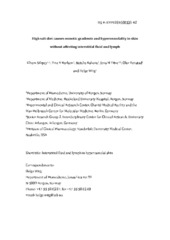High-salt diet causes osmotic gradients and hyperosmolality in skin without affecting interstitial fluid and lymph
Nikpey Esfahlan, Elham; Karlsen, Tine Veronica; Rakova, Natalia; Titze, Jens M.; Tenstad, Olav; Wiig, Helge
Peer reviewed, Journal article
Accepted version
Permanent lenke
https://hdl.handle.net/1956/16663Utgivelsesdato
2017-04Metadata
Vis full innførselSamlinger
Originalversjon
https://doi.org/10.1161/hypertensionaha.116.08539Sammendrag
The common notion is that the body Na+ is maintained within narrow limits for fluid and blood pressure homeostasis. Several studies have, however, shown that considerable amounts of Na+ can be retained or removed from the body without commensurate water loss and that the skin can serve as a major salt reservoir. Our own data from rats have suggested that the skin is hypertonic compared with plasma on salt storage and that this also applies to skin interstitial fluid. Even small electrolyte gradients between plasma and interstitial fluid would represent strong edema-generating forces. Because the water accumulation has been shown to be modest, we decided to reexamine with alternative methods in rats whether interstitial fluid is hypertonic during salt accumulation induced by high-salt diet (8% NaCl and 1% saline to drink) or deoxycorticosterone pellet implantation. These treatments resulted both in increased systemic blood pressure, skin salt, and water accumulation and in skin hyperosmolality. Interstitial fluid isolated from implanted wicks and lymph draining the skin was, however, isosmotic, and Na+ concentration in fluid isolated by centrifugation and in lymph was not different from plasma. Interestingly, by eluting layers of the skin, we could show that there was an osmolality and urea gradient from epidermis to dermis. Collectively, our data suggest that fluid leaving the skin as lymph is isosmotic to plasma but also that the skin can differentially control its own electrolyte microenvironment by creating local gradients that may be functionally important.
